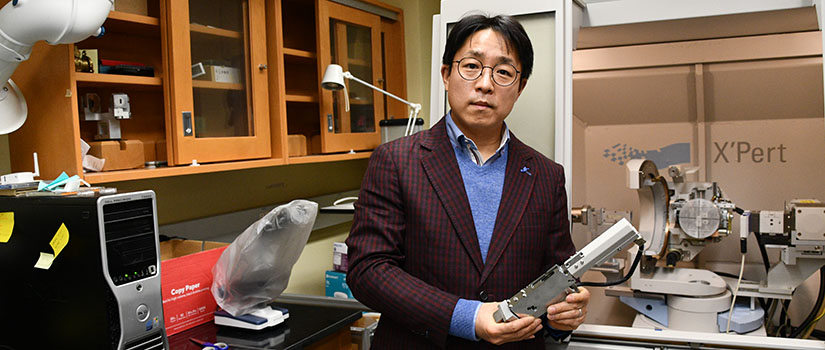Pictured: Dongkyu Lee stands next to a High-resolution X-ray Diffraction (HRXRD) system. HRXRD is a collection of application techniques for the non-destructive analysis of mostly layered, nearly-perfect cyrstalline structured materials.
Heat is inevitably generated during energy production. However, almost two-thirds of the total energy produced by humanity is considered as waste heat and contributes to global warming.
As climate change concerns continue to rise, the efficient recycling of waste heat is an urgent scientific challenge. Mechanical Engineering Assistant Professor Dongkyu Lee recently earned a National Science Foundation (NSF) CAREER Award, and his research will focus on the thermoelectric conversion process, aiming to transform waste heat into useable electric power for clean and sustainable energy. The five-year CAREER project begins on September 1.
“While there are various methods for efficiently recycling waste heat to energy, the thermoelectric conversion process is one of the best and most promising approaches,” Lee says. “The efficiency of thermoelectric devices is mainly dependent on material intrinsic properties, which are thermopower and electric conductivity.”
According to Lee, since efficiency is currently low and in need of improvement, discovering new materials with good thermoelectric properties is crucial for developing high-performance devices. His goal is to advance the development of state-of-the-art oxide thermoelectric materials with high thermopower and high electric conductivity. Thermopower refers to the measure of the magnitude of an induced thermoelectric voltage in response to a temperature difference. Electrical conductivity is the measure of how easily an electric current moves through a substance.
“There is a growing demand for innovative energy conversion and storage applications, and my research aims to facilitate the development of thermoelectric applications for a more efficient utilization of waste heat,” Lee says. “This work will also be more fundamental-based research to understand the behavior of materials. Without this foundational knowledge, meaningful progress is unattainable.”
While conventional thermoelectric materials demonstrate reasonable properties, they often present challenges such as toxicity, scarcity and susceptibility to oxidation at high temperatures. However, Lee’s project will focus on transition metal oxides (TMOs), an intriguing category of electronic and ionic materials that exhibit a diverse range of functionalities. They are also considered promising thermoelectric materials due to their non-toxic nature, abundance and stability at high temperatures. But TMOs do not exhibit good thermoelectric properties, compared to conventional thermoelectric materials.
“We can enhance the thermopower of TMOs by reducing the carrier concentration, which is the number of electrons inside the material, but then electric conductivity remains low. When we increase the electric conductivity by increasing the carrier concentration, the thermopower significantly drops, so it’s basically a trade-off relationship,” Lee says. “The primary motivation of this CAREER award is overcoming this trade-off for enhancing the thermoelectric properties of TMOs.”
Lee will combine two emerging strategies, vertical strain, and redox defect chemistry, to achieve large thermopower and high conductivity in TMOs.
Through funding from the Department of Energy for his vertical strain research, Lee’s group previously developed a novel oxide heterostructure, known as a vertically aligned nanostructure (VAN). The structure enables the creation of vertical interfaces and columnar microstructures, contributing to enhanced material properties.
“My group has a state-of-the-art Pulse Laser Deposition (PLD) system, specifically designed for forming oxide thin films or nanostructures. Using this instrument, we’ve successfully synthesized VANs, which can significantly influence the thermoelectric properties of TMOs through precise control of the vertical strain,” Lee says.
Another approach to modulating the thermoelectric properties of TMOs is the formation of metal particles in materials. But embedding metal particles using conventional methods presents a significant challenge. In Lee’s previous NSF-sponsored project, his group successfully formed metal particles utilizing the redox flexibility of TMOs, known as metal exsolution. Exsolution is a phenomenon where metal particles are segregated from an oxide lattice to an oxide surface under a reducing atmosphere. The method facilitates the enhancement of cohesion between the metal particles and the supporting material.
“The exsolved metal particles and TMOs will form heterointerfaces, where we can expect abnormal behavior of thermoelectric properties,” Lee says. “In this CAREER project, we plan to address the challenge of simultaneously enhancing thermopower and conductivity by leveraging the potential of VAN synthesis using PLD in combination with the metal exsolution.”
Lee added that when heterointerfaces are created through metal exsolution, he expects an energy filtering effect that will lead to enhanced thermopower.
“The formation of VANs allows us to modulate the oxygen vacancy concentration that will directly control the electric conductivity. That is how we can overcome the trade-off relationship between thermopower and electric conductivity,” Lee says.
The project’s innovative approach aims to accommodate an array of functional properties, leading to advancements in energy and electronic applications. Lee’s work will also establish the foundation for developing a long-term goal of expanding the present studies for better understanding the structure-interface-property relationships across various materials for energy applications.
For the educational component of the NSF CAREER Award, Lee is committed to fostering the growth of materials science engineering. He plans to provide lectures and demonstrations to high school students and teachers. In addition, hands-on research training and mentorship opportunities will be provided for underrepresented undergraduate and graduate students to spark their interest in materials science engineering studies and related careers.
“The significance of materials science engineering across many future technologies will increase. But the number of graduates in this discipline remains low, and the academic participation of ethically and diverse individuals in the field is also low,” Lee says. “I will enhance public awareness of the important role of materials science engineering by integrating my research with educational initiatives.”
